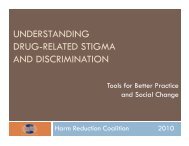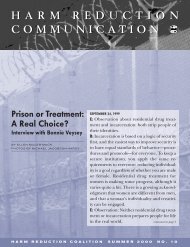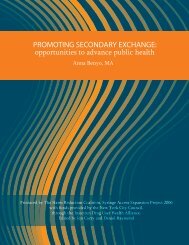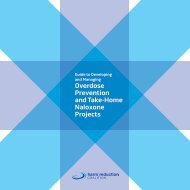9th - Harm Reduction Coalition
9th - Harm Reduction Coalition
9th - Harm Reduction Coalition
Create successful ePaper yourself
Turn your PDF publications into a flip-book with our unique Google optimized e-Paper software.
<strong>9th</strong><br />
National <strong>Harm</strong> <strong>Reduction</strong> Conference<br />
FROM PUBLIC HEALTH TO SOCIAL JUSTICE<br />
Bernstein, Scott, Pivot Legal Society, Vancouver, British Columbia<br />
scott@pivotlegal.org<br />
The Legal Fight for <strong>Harm</strong> <strong>Reduction</strong><br />
The Downtown Eastside of Vancouver, Canada, is home to 4600+ injection drug users. In the 1990s, a dramatic rise of HIV,<br />
hepatitis C, and overdose deaths saw the commitment to create the only legally sanctioned medically supervised injection<br />
site in North America. In eight years of operation, Insite has become the most thoroughly studied medical facility in Canada,<br />
producing dozens of empirical and social science studies. In 2008, the federal government sought to close Insite for ideological<br />
reasons. Following a three-year legal battle ending in the Supreme Court of Canada, it was ordered that Insite must<br />
be allowed to remain open. In a stunning legal ruling, the high court held that if evidence demonstrated that the health<br />
services reduced harm to drug-addicted individuals, the state cannot interfere with their provision. This talk analyzes the<br />
role of research in constitutional rights cases, using Insite as a case study. Exploring the quality and nature of the evidence<br />
presented in this case, we analyze the introduction of scientific evidence into court proceedings and techniques by which<br />
evidence-based policy can be imposed by a court of law. The Insite case is unique in the nature of evidence produced to support<br />
a constitutional right to harm reduction. It serves as a profound teaching tool for legal advocates litigating the right to<br />
harm-reduction services, and for scientists and researchers on the judicial treatment and reliance upon expert evidence in<br />
constitutional lawsuits. The expert evidence produced in this case was critical for persuading the court to declare a legal<br />
right to operate Insite, and served to trump non-evidence-based policy. As Canada explores other innovative ways to deal<br />
with the harms of drug use, this court decision will become a model for introducing scientific evidence into rights determinations<br />
on the path to harm reduction.<br />
Scott heads up Pivot Legal Society’s Health and Drug Policy Campaign Scott received a Master of Science from the University<br />
of Wisconsin in Environmental Studies and a law degree from the University of British Columbia. Scott has worked on several<br />
notable public interest constitutional cases, including taking part in the InSite supervised injection site litigation that was before<br />
the Supreme Court of Canada in 2011.<br />
Berton Martinez, Joanna, Independent, Boston, MA<br />
joannabertonmartinez@gmail.com<br />
PSA Yay! Make a Public Service Announcement >> From Cell Phone to Internet<br />
The purpose of a public service announcement is to persuade. The objective of a PSA is to, 1) raise awareness, and 2) change<br />
public attitudes. THIS HAS HARM REDUCTION WRITTEN ALL OVER IT! The pleasure of a PSA is that you don’t have to pretend<br />
to be unbiased, fair or objective. Make a PSA to make a point. Have an opinion and get creative. PSAs are short – anywhere<br />
from 30 to 60 seconds – this means the message has to be clear and on point! This workshop will give an overview of<br />
what makes a good PSA and will offer cost-saving suggestions on production, like using the camera in your phone or signing<br />
up for the local cable access network or futzing around on your friend’s lap top. We will also talk about where to post the PSA<br />
after it’s made because how are people going to do what you want them to if they don’t know you want them to do it WORD<br />
Bonar, Erin, Addiction Research Center, Ann Arbor, MI<br />
erinbona@med.umich.edu<br />
Injection Drug Users’ Perceived Barriers to Using Self-Initiated <strong>Harm</strong> <strong>Reduction</strong> Strategies.<br />
Injecting drug users (IDUs) engage in self-initiated harm reduction strategies inconsistently. To better understand IDUs’ use<br />
of such strategies, and their perceived barriers to using specific strategies, we interviewed 90 IDUs recruited from needle<br />
exchanges. Participants were asked about behaviors they use to reduce the risks of injecting and about perceived barriers to<br />
using two specific harm reduction strategies (i.e., test shots and pre-injection skin cleaning) designed to reduce two health<br />
outcomes (i.e., overdose and bacterial infections, respectively). Participants described using a range of risk reduction prac-<br />
10











